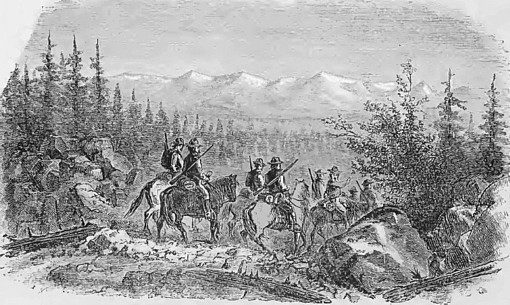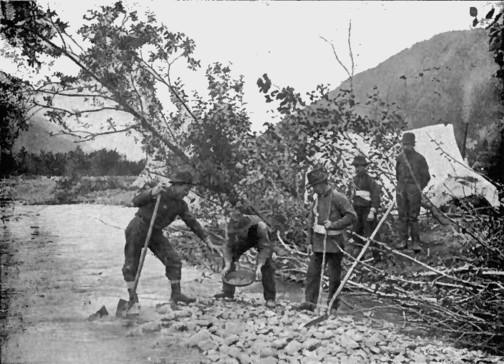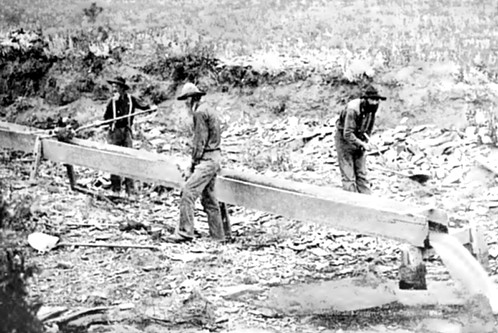Gold was discovered in Oregon before it was found in California, and the yellow metal still brings wealth to the State today. Many of the pioneers who arrived in Oregon in the early 1850s were bent on speculation more than any who had come before them; the gold rush fever had overturned ideas of plodding industry and slow accumulation. Some however, came for pleasure and observation. Among the arrivals were many children, made orphans en route by the difficulties of the travel. Under the excitement of gold seeking and the spirit of adventure awakened by it, the entire great north western seaboard was opened to settlement with marvelous rapidity. A rage for discovery and prospecting possessed the people, and produced in a short time very marked results. From the Klamath River to Puget Sound, and from the upper Columbia to the sea, men were spying out mineral wealth or laying plans to profit by the operations of those who preferred the risks of the gold-fields to other and more settled pursuits. In the spring of 1850 an association of seventy persons was formed in San Francisco to discover the mouth of Klamath River, believed at the time, owing to an error of Fremont's map, to be in Oregon. The object was wholly speculative, and included besides hunting for gold the opening of a road to the mines of northern California, the founding of towns at the most favorable points on the route, with other enterprises. In passing back and forth to California, the Oregon miners had not failed to observe that the same soil and geological structure characterized the valleys in Oregon north of the supposed northern boundary of California. Because the same geology that was found in the known California mining regions, the occurrence of gold in Oregon was likely and prospecting was carried on to a considerable extent early in 1850. In June two hundred miners were at work in the Umpqua Valley. But little gold was found at this time, and the movement was southward, mostly to the Rogue River and Klamath.
Below is a collection of 6 tales of adventure and history from Oregon's early gold mining days:
1.
Gold Rush To the Beach Mines of
Oregon
2. Eastern Oregon Gold and Silver Mines
3. Eastern Oregon Gold Fields, Part I
4. Eastern Oregon Gold Fields, Part II
5. Eastern Oregon Gold Fields, Part III
6. Eastern Oregon Gold Fields, Part IV

According to the best authorities the first important discovery on any of the tributaries of the Klamath was in the spring of 1850 at Salmon Creek. In July discoveries were made on the main Klamath, ten miles above the mouth of Trinity River, and in September on Scott River. In the spring of 1851 native gold was found in the Shasta Valley, at various places, notably on Greenhorn Creek, Yreka, and Humbug Creek.
The Oregon miners were by this time satisfied that gold existed north of the Siskiyou range. Their explorations resulted in finding the golden metal on Big Bar of Rogue River, and in the canon of Josephine Creek. Meanwhile the beautiful and richly grassed valley of Rogue River became the paradise of packers, who grazed their mules there, returning to Scottsburg or the Willamette for a fresh cargo. In February 1852 one Sykes who worked on the place of A. A. Skinner found gold on Jackson Creek, about on the west line of the present town of Jacksonville, and soon after two packers, Cluggage and Pool, occupying themselves with prospecting while their animals were feeding, discovered Rich Gulch, half a mile north of Sykes' discovery. The wealth of these mines led to an irruption from the California side of the Siskiyou, and miners began to rush to Willow Springs five miles north of Jacksonville, Pleasant Creek, Applegate Creek, and many other mining localities all of which became deservedly famous, yielding large amounts of gold for a good number of years.
Every miner, settler, and trader in this remote interior region was anxious to hear from friends, home, and of the great commercial world without. As I have before said Thurston labored earnestly to show congress the necessity of better mail facilities for Oregon, the benefit intended to have been conferred having been diverted almost entirely to California by the exigencies of the larger population and business of that state with its phenomenal growth. To accomplish this, roads were required, and from Winchester the route was extended to the mines in the Umpqua and Rogue River valleys. Long trains of mules laden with goods for the mining region filed daily along the precipitous path which was dignified with the name of road, their tinkling bells striking cheerily the ear of the lonely traveler plodding his weary way to the gold-fields. Scottsburg, which was the point of departure for the pack-trains, became a commercial entry point of importance. The influence of the Umpqua interest was sufficient to obtain from congress at the session of 1850-51 appropriations for mail service by sea and land, a light-house at the mouth of the river, and a separate collection district. As the mines were opened permanent settlements were made upon the farming lands of southern Oregon, and various small towns were started from 1851 to 1853 in the region south of Winchester, notably the town of Roseburg, founded by Aaron Rose, who purchased the claim from its locators for a horse, and a poor one at that.
Even though non-metallic products comprise the bulk of Oregon's mineral output, the State has also produced several important metal ores. In addition to gold quartz from Josephine, Grant, and Baker counties, Oregon produces aluminum, copper, lead, mercury, nickel, silver, steel, uranium oxide and zinc. Jackson and Coos counties are the State's largest suppliers of copper ore, although some ore has also been mined in Lane, Douglas, and Baker counties. Lead ore comes from Grant and Lane counties; Malheur and Harney counties have been Oregon's leading mercury producers . Douglas County is the source of virtually all the nickel ore produced in the State; Grant, Lane, Coos, and Baker counties mine silver ore while Lake and Lane are the principal centers for uranium ore and zinc production. Steel output is concentrated at Portland, in Multnomah County.


